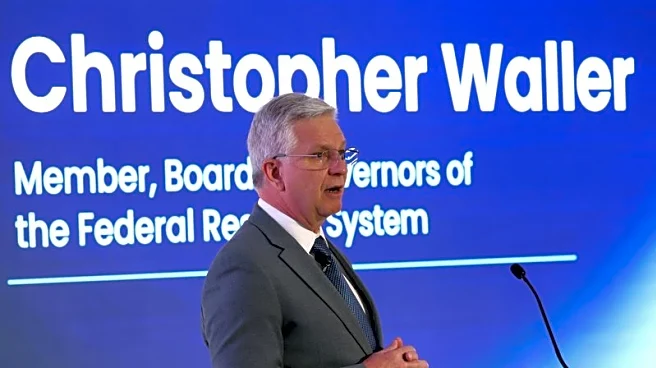What's Happening?
Federal Reserve Governor Christopher Waller addressed the economic outlook, highlighting the challenges posed by conflicting data on economic growth and labor market conditions. Since the Federal Open
Market Committee's last meeting, data has shown a softening labor market alongside solid economic activity, creating a dilemma for monetary policy. The recent government shutdown has delayed critical economic data, complicating the assessment of inflation and employment trends. Waller noted that tariffs have temporarily increased inflation rates, but expects these effects to fade, aligning inflation closer to the FOMC's 2 percent target. He emphasized the importance of resolving the conflict between economic growth and labor market data to guide future monetary policy decisions.
Why It's Important?
The delayed release of economic data due to the government shutdown poses significant challenges for the Federal Reserve's ability to make informed policy decisions. Accurate data is crucial for assessing inflation and employment trends, which directly impact monetary policy settings. The ongoing tariff effects on inflation add complexity to the Fed's goal of maintaining price stability. The softening labor market, despite strong economic activity, raises concerns about future employment and wage growth. These factors are critical for businesses and consumers, influencing spending, investment, and overall economic confidence. The Fed's approach to monetary policy will have broad implications for economic stakeholders, including businesses, workers, and investors.
What's Next?
Governor Waller indicated that the Federal Reserve might consider easing monetary policy further, depending on how the conflict between economic growth and labor market data resolves. The upcoming release of delayed economic reports, including the consumer price inflation report, will be crucial for informing the FOMC's policy decision. The Fed is expected to closely monitor the labor market and inflation trends to determine the appropriate path for interest rates. The resolution of the government shutdown and its impact on economic data will also play a significant role in shaping future policy actions. Stakeholders, including businesses and policymakers, will be watching closely for signs of stabilization or further softening in the labor market.
Beyond the Headlines
The speech by Governor Waller highlights the broader implications of artificial intelligence on the labor market. AI adoption may reduce demand for workers, posing a structural shift that monetary policy may not effectively address. While AI could lead to productivity gains, its impact on employment remains uncertain, particularly for lower-income households. The reliance on higher-income consumers for economic growth underscores the vulnerability of the broader economy to shifts in spending patterns. These factors could influence long-term economic trends and policy considerations, as the Fed navigates the complexities of technological advancements and income disparities.












